White House Press Secretary Jen Psaki had a typical, elitist response when asked by reporters why Joe Biden broke his own rule hours after signing a mask mandate executive order.
Psaki was asked earlier today by Fox News reporter Peter Doocey why Biden broke his own executive order last night and did not wear a mask while visiting the Lincoln Memorial with his family—who were also maskless.
“He was celebrating an evening of a historic day in our country and certainly he signed the mask mandate because it’s a way to send a message to the American public about the importance of wearing masks, how it can save tens of thousands of lives,” said Psaki.
Jen Psaki is asked why Joe Biden and members of his family weren't wearing masks at the Lincoln Memorial last night after signing the mask mandate on federal lands:
"He was celebrating a historic day in our country… We have bigger things to worry about." pic.twitter.com/wLjD1V0k1f
— Daily Caller (@DailyCaller) January 21, 2021
The executive order, which he signed yesterday, which “mandates masks in federal buildings, on federal lands, and on airlines, trains, and other transit systems that commute between states.”
When pressed by Doocey if Biden set a good example by going out maskless, Psaki explained that Biden had a historic day and was “surrounded by his family.”
“I think we have bigger issues to worry about at this moment in time,” she said.
It’s interesting that Biden is allowed to be “surrounded by his family,”—maskless—while every day Americans are told by government officials to isolate themselves from non-household family members for months on end for fear of killing grandma.
“Rules for thee, but not for me,” seems to be a theme when it comes to lockdown-loving, mask-mandating hypocritical Democrat leaders across the country.
Media Says No Proof Of Election Fraud, Well Here's 3 States Worth of Proof
Whether it’s the mainstream media, Twitter, Facebook or any other platform with a leftist agenda, all you hear is that there is “no evidence” of election fraud.
Well, the Data Integrity Group (DIG) has showcased a mountain of evidence across several states and has so far released videos with their findings on Arizona, Georgia and Pennsylvania.
The goal of the group is to present irrefutable data. Sources for the raw data they used come from the Edison, Secretary of State, and SCYTL feeds which is what was used to certify the election totals.
Below is hard evidence from the data for those in the media and Democrats who continue to say there is no proof of fraud.
Pennsylvania
In this first slide the data scientists show negative votes across 15 counties in PA that total over 400,000 votes taken from President Trump. There is no question of whether or not this happened, this is the data used to verify the state–once again Edison, SOS and SCYTL data.
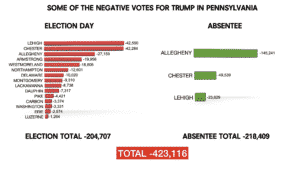
In the next two PA slides you can see in Allegheny County that absentee votes went up on a normal gradual scale for Joe Biden.
In Trumps slide you can see at the second time stamp there was an injection of 145,241 votes and then they are all taken away.


Trump’s Election Day votes in Allegheny were taken away as well at five different time intervals throughout the night, totaling over 25,000 votes which is confirmed across multiple data sources.
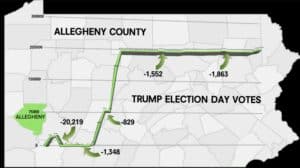
Here is Chester County PA where President Trump saw major decreases in votes across absentee and Election Day votes:

Lehigh County PA saw an over 66,000 vote drop for Trump:
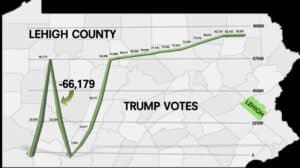
Philadelphia has a history of corruption and this election looks no different. In this slide you can see the data shows Biden received a 47:1 vote ratio over Trump. Trump received 2,152 votes to Biden’s 100,236. In 278 precincts in Philadelphia it would mean 97 out of 100 people voted for Joe Biden. Some precincts showed 99% for Biden.
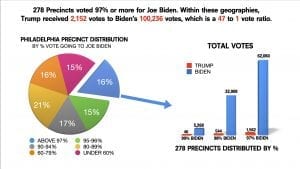
Georgia
In Bibb County, GA you can see there was an exact vote switch between Trump and Biden of 12,173, giving Biden the lead.
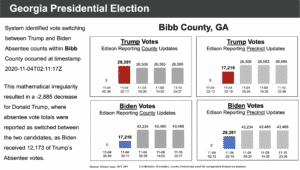
When we asked local residents about these numbers in DeKalb they said it’s impossible that 9 out of 10 people voted for Biden in their county.
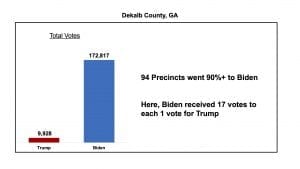
Fulton County seems to have as much corruption as Philadelphia. But strictly looking at the data, 170 out of 384 precincts in Fulton County voted 90% or more for Joe Biden.
Trump received only 9% of Election Day votes and 4% of absentee in Fulton. There were several counties that reported 100% for Biden. These numbers represent statistical anomalies that do not exist in normal behavioral patterns.
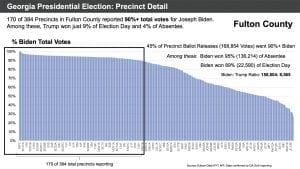
Arizona
As you can see all the gray bars are relatively even, which is what you would encounter with normal vote distribution. Statistically speaking, the blue bars, which all represent the first batch of absentee votes for Biden, should be roughly in line with the grey bars. Instead the massive difference in votes between the first batch and the rest implies a potential front load of votes for Biden in order to secure his win in the state.
Questions and rebuttals arose that these spikes in the first drop came because more people early voted for Biden, but our second slide shows that there was an even amount of requests by Republicans for early vote ballots and an even amount of returns by Republicans which throws that argument out. Also these large early vote drops were not consistent across the state.
In order to make those numbers work Biden would have to have received 100% of the Democrats, 100% of the Independents and a large portion of the Republicans.
Sources confirm that 95% of registered republicans voted for Trump.
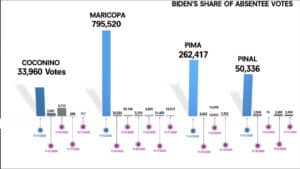
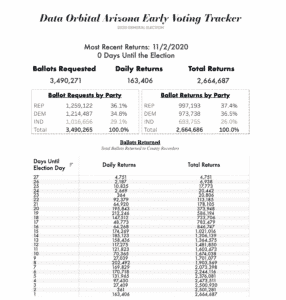
There is a large group of data scientist that are working on this data around the clock to showcase all the irregularities within the election.
Information on more states is still to come, including data on down ticket races.
Can You Hack an Election in 7 Minutes?
Can an election be hacked in seven minutes?
Andrew Appel, a professor at Princeton University set out to do just that, hack into a voting machine. In order to do this he could have tried traditional ways of hacking or writing malware to sneak on to a machine at a polling place that are left unguarded for days, but he decided it was much easier to just buy one online.
For the cost of a whole $82, Appel became the proud owner of a behemoth machine called Sequoia AVC Advantage. This machine is one of the oldest and most vulnerable in the US and is unfortunately used in places like Louisiana, New Jersey, Virginia and Pennsylvania.
No sooner did a team of bewildered deliverymen roll the 250-pound device into a conference room near Appel’s cramped, third-floor office than the professor set to work. He summoned a graduate student named Alex Halderman, who could pick the machine’s lock in seven seconds.
Clutching a screwdriver, he deftly wedged out the four ROM chips—they weren’t soldered into the circuit board, as sense might dictate—making it simple to replace them with one of his own: A version of modified firmware that could throw off the machine’s results, subtly altering the tally of votes, never to betray a hint to the voter. The attack was concluded in minutes.
To mark the achievement, his student snapped a photo of Appel—oblong features, messy black locks and a salt-and-pepper beard—grinning for the camera, fists still on the circuit board, as if to look directly into the eyes of the American taxpayer: Don’t look at me—you’re the one who paid for this thing.

Appel’s mischief might be called an occupational asset: He is part of a diligent corps of so-called cyber-academics—professors who have spent the past decade serving their country by relentlessly hacking it.
Electronic voting machines—particularly a design called Direct Recording Electronic, or DRE’s—took off in 2002, in the wake of Bush v. Gore. For the ensuing 15 years, Appel and his colleagues have deployed every manner of stunt to convince the public that the system is pervasively unsecure and vulnerable.
Beginning in the late ’90s, Appel and his colleague, Ed Felten, a pioneer in computer engineering now serving in the White House Office of Science and Technology Policy, marsha led their Princeton students together at the Center for Information Technology Policy (where Felten is still director).
There, they relentlessly hacked one voting machine after another, transforming the center into a kind of Hall of Fame for tech mediocrity: reprogramming one popular machine to play Pac-Man; infecting popular models with self-duplicating malware; discovering keys to voting machine locks that could be ordered on eBay.
Eventually, the work of the professors and Ph.D. students grew into a singular conviction: It was only a matter of time, they feared, before a national election—an irresistible target—would invite an attempt at a coordinated cyberattack.
There is no singular national body that regulates the security or even execution of what happens on Election Day, and there never has been. It’s a process regulated state by state.
The Princeton group has a simple message: That the machines that Americans use at the polls are less secure than the iPhones they use to navigate their way there. They’ve seen the skeletons of code inside electronic voting’s digital closet, and they’ve mastered the equipment’s vulnerabilities perhaps better than anyone (a contention the voting machine companies contest, of course).
They insist the elections could be vulnerable at myriad strike points, among them the software that aggregates the precinct vote totals, and the voter registration rolls that are increasingly digitized. But the threat, the cyber experts say, starts with the machines that tally the votes and crucially keep a record of them—or, in some cases, don’t.
Cleary hacking into voting machines is an easy task, which is a major concern for our democracy. If powerful people with money and resources want to stay in control, we now know they can make that happen very easily.










